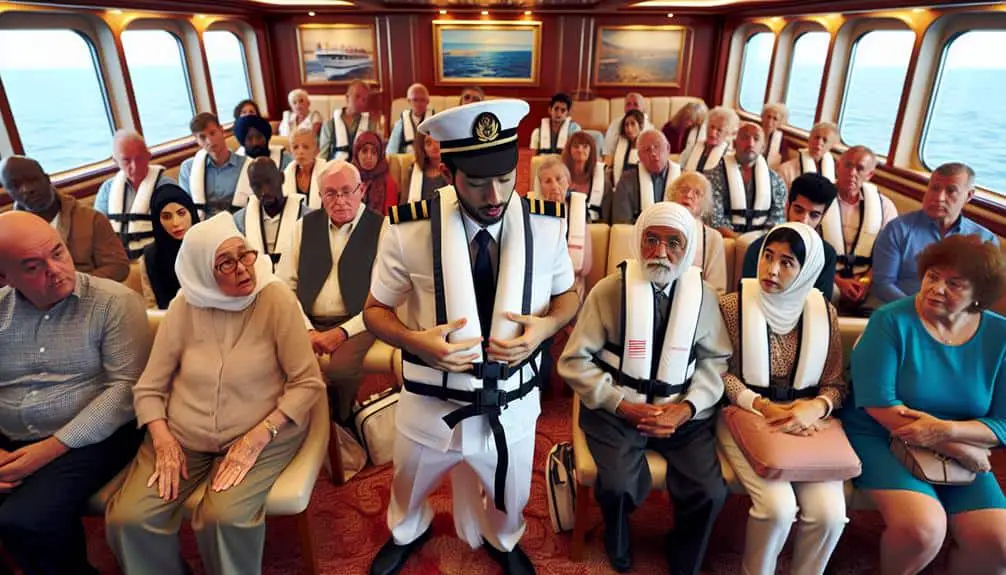Master essential cruise ship safety briefing tips: Be prepared for emergencies. Pay attention, ask questions, locate emergency equipment. Find your muster station. Engage in drills to guarantee readiness. Know emergency procedures, life jackets, alarms. Familiarize yourself with safety signage. Understand evacuation protocols, exits, assembly stations. Learn how to properly use a life jacket. Ensure a snug fit; adjust straps correctly. Following these tips will help you stay safe onboard.
Key Points
- Pay attention to safety briefings for emergency preparedness.
- Familiarize yourself with muster stations and emergency equipment.
- Actively participate in mandatory safety drills for readiness.
- Understand emergency evacuation protocols for swift response.
- Properly adjust and wear life jackets for crucial safety.
Importance of Safety Briefings
During a cruise, understanding the importance of safety briefings guarantees every passenger is prepared for any potential emergency scenario. Safety awareness is paramount on a cruise ship. Grasping the safety procedures and protocols ensures that you're ready to act swiftly and effectively in case of an emergency. As a passenger, it's your duty to pay attention during safety briefings, ask questions if needed, and familiarize yourself with the location of life jackets, emergency exits, and muster stations.
Passenger responsibility also includes following the instructions provided by the crew in the event of an emergency. During the safety briefing, you'll receive vital information on how to evacuate the ship, use life-saving equipment, and other essential emergency procedures. Take the time to listen attentively and take note of where your designated muster station is located. Remember, being prepared can make a significant impact in ensuring your safety and the safety of others onboard.
Mandatory Safety Drill Procedures
To guarantee the safety and readiness of all passengers, the cruise ship enforces mandatory safety drill procedures that are essential for emergency preparedness. Participation in these drills is vital to make sure that everyone on board is well-informed and prepared in case of any unforeseen circumstances. During the drill, passengers are required to familiarize themselves with emergency procedures, such as locating life jackets, understanding alarm signals, and identifying muster stations. It's imperative that all passengers actively engage in the drill to maximize their understanding of the safety protocols onboard.
The crew members will provide clear instructions and guidance throughout the drill to ensure that everyone comprehends the necessary steps to take in case of an emergency. By actively participating in the safety drill, passengers can greatly increase their chances of responding effectively in real-life emergency situations. Remember, the safety of all individuals onboard is of paramount importance, and being well-versed in emergency procedures through drill participation is a crucial aspect of ensuring a safe and secure cruise experience.
Key Safety Information Locations
Be sure you're familiar with the main safety information locations onboard the cruise ship to quickly access important emergency procedures and equipment. Safety signage locations are strategically placed throughout the ship, highlighting important safety information such as emergency exits, life jacket storage areas, and muster stations.
Pay close attention to safety video screenings at the beginning of your voyage, as they provide essential instructions on what to do in case of emergencies.
In addition to these visual aids, familiarize yourself with the emergency response drills that are conducted regularly on the ship. These drills are designed to prepare passengers for potential emergencies and guarantee a swift and organized response from both passengers and crew members.
Knowing the location of your designated passenger muster station is essential, as this is where you'd gather in the event of an emergency to receive further instructions and assistance.
Emergency Evacuation Protocols
Get to know the emergency evacuation protocols onboard the cruise ship to make sure you're prepared for swift and safe evacuation procedures in the case of emergencies. Evacuation procedures are vital for guaranteeing the safety of all passengers and crew in the event of an emergency situation.
Familiarize yourself with the location of emergency exits on the ship, as well as the designated assembly stations where you should gather in case of evacuation. Pay close attention to safety precautions outlined during the safety briefing, which may include instructions on how to properly don a life jacket and the importance of following crew members' directions during an evacuation.
In the event of an emergency, remain calm and follow the evacuation procedures as instructed. Remember that your safety and the safety of others depend on your ability to adhere to these protocols effectively. Stay informed and prepared to ensure a smooth and orderly evacuation process if the need arises.
Understanding Life Jacket Usage
Acquaint yourself with the proper usage of life jackets on the cruise ship for your safety during emergency situations. Understanding how to correctly use a life jacket is essential in guaranteeing your well-being in case of a ship emergency.
Start by paying close attention to the life jacket demonstration provided at the beginning of your cruise. This demonstration will guide you on how to properly wear and secure your life jacket.
When fitting your life jacket, make sure it's snug but not too tight. Adjust the straps to ensure a secure fit, with the jacket sitting high on your chest and the straps fastened securely. Check that the jacket doesn't ride up when you lift your arms. Remember, a properly fitted life jacket can be a lifesaver during emergencies at sea.
Frequently Asked Questions
Are Children Required to Attend the Safety Briefing, and if So, What Age Range Is Considered a Child?
During the safety briefing, child attendance is typically mandatory for those between the ages of 1 to 17. Safety briefing accommodations are available to guarantee all passengers, including children, are well-versed in onboard safety protocols.
Can Passengers Bring Their Own Life Jackets on Board, and if Not, What Type of Life Jackets Are Provided?
You cannot bring your own life jacket onboard. Cruise ships provide life jackets for passengers. These can vary but are typically designed to meet safety regulations. Make sure you wear appropriate safety briefing attire for a thorough understanding of onboard procedures.
What Is the Protocol for Passengers With Mobility Issues or Disabilities During an Emergency Evacuation?
In case of an emergency on the cruise ship, evacuation assistance is available for passengers with mobility issues or disabilities. Emergency protocols guarantee your safety, providing necessary support and guidance throughout the evacuation process.
Are There Designated Meeting Points for Families or Groups in Case of an Emergency Evacuation?
During an emergency evacuation on a cruise ship, designated areas for families or groups are essential for accountability and safety. Familiarize yourself with emergency procedures to know where to meet loved ones efficiently.
Are There Any Specific Safety Tips or Procedures for Passengers With Medical Conditions or Special Needs That Should Be Addressed During the Safety Briefing?
During the safety briefing on the cruise ship, passengers with medical conditions or special needs should inform the crew. Procedures and tips will be provided to guarantee your safety. Pay close attention for essential information customized to your needs.




